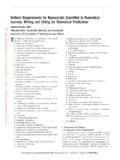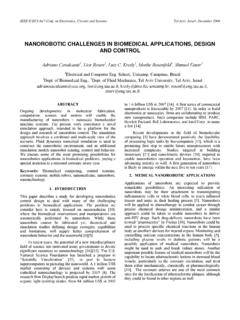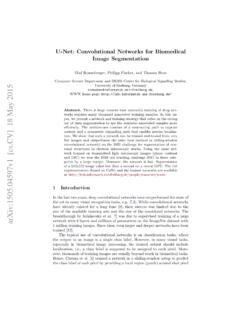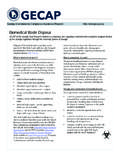Transcription of Section III—Principles of Biosafety
1 22 Biosafety in Microbiological and biomedical LaboratoriesSection III principles of BiosafetyA fundamental objective of any Biosafety program is the containment of potentially harmful biological agents. The term containment is used in describing safe methods, facilities and equipment for managing infectious materials in the laboratory environment where they are being handled or maintained. The purpose of containment is to reduce or eliminate exposure of laboratory workers, other persons, and the outside environment to potentially hazardous agents. The use of vaccines may provide an increased level of personal protection. The risk assessment of the work to be done with a specific agent will determine the appropriate combination of these Practices and TechniqueThe most important element of containment is strict adherence to standard microbiological practices and techniques.
2 Persons working with infectious agents or potentially infected materials must be aware of potential hazards, and must be trained and proficient in the practices and techniques required for handling such material safely. The director or person in charge of the laboratory is responsible for providing or arranging the appropriate training of laboratory should develop or adopt a Biosafety or operations manual that identifies the hazards that will or may be encountered, and that specifies practices and procedures designed to minimize or eliminate exposures to these hazards. Personnel should be advised of special hazards and should be required to read and follow the required practices and procedures. A scientist, trained and knowledgeable in appropriate laboratory techniques, safety procedures, and hazards associated with handling infectious agents must be responsible for the conduct of work with any infectious agents or materials.
3 This individual should consult with Biosafety or other health and safety professionals with regard to risk standard laboratory practices are not sufficient to control the hazards associated with a particular agent or laboratory procedure, additional measures may be needed. The laboratory director is responsible for selecting additional safety practices, which must be in keeping with the hazards associated with the agent or facility design and engineering features, safety equipment, and management practices must supplement laboratory personnel, safety practices, and Equipment (Primary Barriers and Personal Protective Equipment)Safety equipment includes BSCs, enclosed containers, and other engineering controls designed to remove or minimize exposures to hazardous biological materials.
4 The BSC is the principal device used to provide containment of principles of Biosafety 23infectious droplets or aerosols generated by many microbiological procedures. Three types of BSCs (Class I, II, III) used in microbiological laboratories are described and illustrated in Appendix A. Open-fronted Class I and Class II BSCs are primary barriers that offer significant levels of protection to laboratory personnel and to the environment when used with good microbiological techniques. The Class II biological safety cabinet also provides protection from external contamination of the materials ( , cell cultures, microbiological stocks) being manipulated inside the cabinet. The gas-tight Class III biological safety cabinet provides the highest attainable level of protection to personnel and the example of another primary barrier is the safety centrifuge cup, an enclosed container designed to prevent aerosols from being released during centrifugation.
5 To minimize aerosol hazards, containment controls such as BSCs or centrifuge cups must be used when handling infectious equipment also may include items for personal protection, such as gloves, coats, gowns, shoe covers, boots, respirators, face shields, safety glasses, or goggles. Personal protective equipment is often used in combination with BSCs and other devices that contain the agents, animals, or materials being handled. In some situations in which it is impractical to work in BSCs, personal protective equipment may form the primary barrier between personnel and the infectious materials. Examples include certain animal studies, animal necropsy, agent production activities, and activities relating to maintenance, service, or support of the laboratory Design and Construction (Secondary Barriers)The design and construction of the facility contributes to the laboratory workers protection, provides a barrier to protect persons outside the laboratory, and protects persons or animals in the community from infectious agents that may be accidentally released from the laboratory.
6 Laboratory directors are responsible for providing facilities commensurate with the laboratory s function and the recommended Biosafety level for the agents being recommended secondary barrier(s) will depend on the risk of transmission of specific agents. For example, the exposure risks for most laboratory work in BSL-1 and BSL-2 facilities will be direct contact with the agents, or inadvertent contact exposures through contaminated work environments. Secondary barriers in these laboratories may include separation of the laboratory work area from public access, availability of a decontamination facility ( , autoclave), and hand washing the risk of infection by exposure to an infectious aerosol is present, higher levels of primary containment and multiple secondary barriers may become necessary to prevent infectious agents from escaping into the environment.
7 Such design features include specialized ventilation systems to 24 Biosafety in Microbiological and biomedical Laboratoriesensure directional airflow, air treatment systems to decontaminate or remove agents from exhaust air, controlled access zones, airlocks at laboratory entrances, or separate buildings or modules to isolate the laboratory. Design engineers for laboratories may refer to specific ventilation recommendations as found in the ASHRAE Laboratory Design Guide published by the American Society of Heating, Refrigerating, and Air-Conditioning Engineers (ASHRAE).1 Biosafety LevelsFour BSLs are described in Section 4, which consist of combinations of laboratory practices and techniques, safety equipment, and laboratory facilities.
8 Each combination is specifically appropriate for the operations performed, the documented or suspected routes of transmission of the infectious agents, and the laboratory function or activity. The BSLs described in this manual should be differentiated from Risk Groups, as described in the NIH Guidelines and the World Health Organization Laboratory Biosafety Manual. Risk groups are the result of a classification of microbiological agents based on their association with, and resulting severity of, disease in humans. The risk group of an agent should be one factor considered in association with mode of transmission, procedural protocols, experience of staff, and other factors in determining the BSL in which the work will be recommended Biosafety level(s) for the organisms in Section VIII (Agent Summary Statements) represent those conditions under which the agent ordinarily can be safely handled.
9 Of course, not all of the organisms capable of causing disease are included in Section VIII and an institution must be prepared to perform risk assessments for these agents using the best available information. Detailed information regarding the conduct of biological risk assessments can be found in Section II. The laboratory director is specifically and primarily responsible for assessing the risks and applying the appropriate Biosafety levels. The institution s Biological Safety Officer (BSO) and IBC can be of great assistance in performing and reviewing the required risk assessment. At one point, under the NIH Guidelines, BSOs were required only when large-scale research or production of organisms containing recombinant DNA molecules was performed or when work with recombinant DNA molecules was conducted at BSL-3 or above.
10 IBCs were required only when an institution was performing non-exempt recombinant DNA experiments. Today, however, it is strongly suggested that an institution conducting research or otherwise working with pathogenic agents have a BSO and properly constituted and functioning IBC. The responsibilities of each now extend beyond those described in the NIH Guidelines and depend on the size and complexity of the , work with known agents should be conducted at the Biosafety level recommended in Section VIII. When information is available to suggest that virulence, pathogenicity, antibiotic resistance patterns, vaccine and treatment availability, or other factors are significantly altered, more (or less) stringent principles of Biosafety 25practices may be specified.















